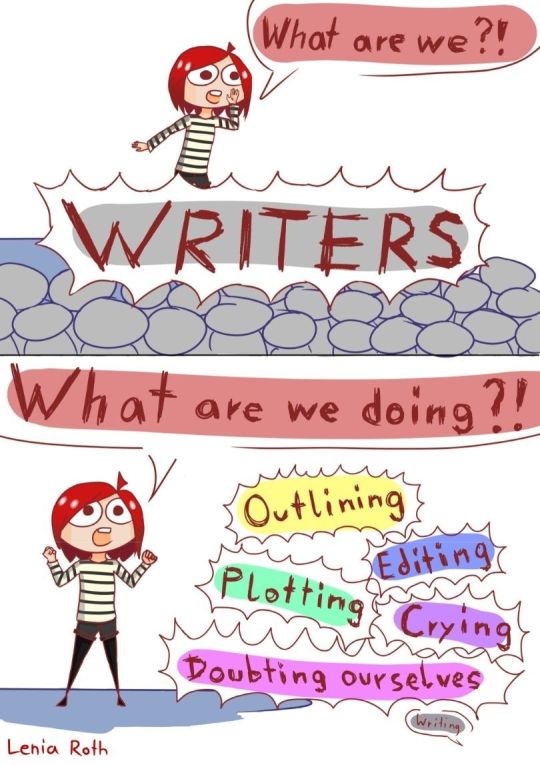#writer blog
Text
Encouragment for writers that I know seems discouraging at first but I promise it’s motivational-
• Those emotional scenes you’ve planned will never be as good on page as they are in your head. To YOU. Your audience, however, is eating it up. Just because you can’t articulate the emotion of a scene to your satisfaction doesn’t mean it’s not impacting the reader.
• Sometimes a sentence, a paragraph, or even a whole scene will not be salvagable. Either it wasn’t necessary to the story to begin with, or you can put it to the side and re-write it later, but for now it’s gotta go. It doesn’t make you a bad writer to have to trim, it makes you a good writer to know to trim.
• There are several stories just like yours. And that’s okay, there’s no story in existence of completely original concepts. What makes your story “original” is that it’s yours. No one else can write your story the way you can.
• You have writing weaknesses. Everyone does. But don’t accept your writing weaknesses as unchanging facts about yourself. Don’t be content with being crap at description, dialogue, world building, etc. Writers that are comfortable being crap at things won’t improve, and that’s not you. It’s going to burn, but work that muscle. I promise you’ll like the outcome.
#hope that helps!#writers on tumblr#writing help#writing advice#writing tumblr#writer tips#writing blog#writing tips#writing tip#writblr#writing#fanfic writers#writeblr#writer blog#writers of tumblr#ya novels#fanfiction#original fiction
24K notes
·
View notes
Text
The Writer's Guide to Authentic Wounds and Fatalities
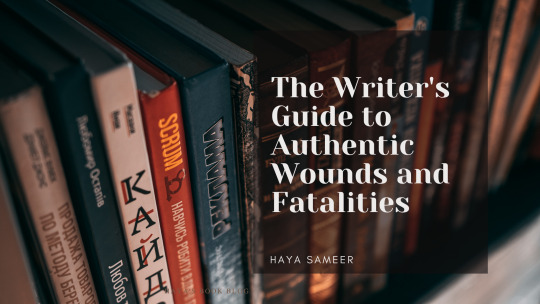
Writing fatal injuries in a story requires a delicate balance between realism and narrative impact. The portrayal of these life-altering events can evoke strong emotions in readers and shape the trajectory of your characters' journeys. In this blog, I will explore the intricacies of depicting fatal injuries in a manner that feels authentic, engaging, and respectful to the gravity of such circumstances. By understanding the nuances of fatal injuries, you will be equipped to craft compelling narratives that resonate with your readers.
Writing Fatal Injuries
When it comes to writing fatal injuries, it is crucial to approach the subject with care and accuracy. Fatal injuries carry immense consequences for your characters and can shape the trajectory of your story. By delving into the intricacies of portraying fatal injuries authentically, you can ensure that the gravity and impact of such events are effectively conveyed to your readers.
Choosing the right injuries for your story
Selecting the appropriate fatal injuries for your narrative involves considering various factors. Ask yourself: What purpose does this injury serve within the story? How does it affect the characters and the overall plot? Conduct thorough research to identify injuries that align with your story's context and resonate with the emotional journey of your characters.
For example, in a historical drama, you may research common fatal injuries during a particular era, such as battlefield injuries, diseases, or accidents prevalent at the time. In a crime thriller, you might explore the portrayal of fatal gunshot wounds or traumatic injuries resulting from violent encounters. By aligning the injuries with the context and themes of your story, you create a more immersive and believable experience for your readers.
Researching the mechanics of fatal injuries
To portray fatal injuries convincingly, it is essential to delve into the mechanics behind them. Understand the specific anatomical structures and systems involved, as well as the forces or mechanisms that can lead to fatal outcomes. Explore medical resources, consult experts if possible, and gather insights into the physiological and psychological implications of such injuries.
For instance, if your character suffers a fatal stab wound, research the anatomy involved, the potential organs affected, and the potential consequences such as internal bleeding or organ failure. By understanding the specific details and implications of the injury, you can describe the physical and emotional toll it takes on the character with greater accuracy and depth.
Depicting the immediate aftermath
When writing about fatal injuries, vividly describe the immediate aftermath to capture the intense emotions and physical realities. Consider the sensory details, the shock and disbelief experienced by characters, and the chaotic environment that often surrounds such events. Balancing realism with the needs of your story, create a scene that immerses readers and evokes empathy.
For example, if a character experiences a fatal car accident, you can depict the chaos at the scene, the character's disorientation, and the reactions of witnesses. Emphasize the sensory details such as the sound of screeching tires or the smell of burning rubber, creating a visceral experience for your readers.
Emotional and dramatic impact on the narrative
The impact of fatal injuries extends beyond the immediate moment. Explore the ripple effects on other characters, relationships, and the overall plot. Delve into the emotional responses, grief, guilt, anger, or determination that arises in the aftermath of loss. Utilize these emotional arcs to deepen character development and drive the narrative forward.
For instance, the loss of a loved one due to a fatal illness might lead to grief and strained relationships among the remaining family members. The emotional journey of a character grappling with guilt and seeking redemption after causing a fatal accident can become a central theme in your story. By delving into these emotional arcs and their consequences, you add depth and resonance to your narrative.
Writing Minor Injuries
While fatal injuries may capture our attention with their dramatic impact, it is equally important to pay attention to the portrayal of minor injuries in your writing. Minor injuries, though less severe, can still significantly affect your characters and contribute to the authenticity of your story. In this section, we will explore the art of depicting minor injuries, ensuring that they are not overlooked or trivialized. By delving into the nuances of minor injuries, you can add depth and realism to your characters' experiences.
Types of minor injuries to consider
When crafting your story, it is essential to consider a range of minor injuries that can occur. These injuries can include cuts, bruises, sprains, minor burns, or even minor fractures. Each type of injury carries its own unique characteristics, associated pain levels, and recovery processes. By understanding these distinctions, you can create accurate and believable depictions that resonate with your readers.
For example, a character who sustains a cut on their hand may experience sharp pain, the sight of blood, and the need for immediate first aid. On the other hand, a character with a sprained ankle may struggle with mobility, experience swelling, and require rest and care for a few days. By paying attention to these specific details, you can enhance the realism of your storytelling.
Conveying pain and discomfort
When writing about minor injuries, it is important to effectively convey the pain and discomfort experienced by your characters. Consider describing the sensation of pain, the throbbing or stinging feeling, and how it affects their daily activities or interactions. Showcasing the emotional impact of pain, such as frustration, irritation, or vulnerability, can deepen the readers' connection to the character's experience.
For instance, if a character suffers from a sprained wrist, you can describe the dull ache that persists, making simple tasks like typing or holding objects challenging. By capturing these small but significant moments, you immerse readers in the character's struggle and create a more realistic portrayal.
Balancing realism with narrative pace
While it is important to depict minor injuries realistically, it is also crucial to strike a balance with the overall pace and momentum of your story. Consider the significance of the injury within the larger context of your narrative. Some injuries may require more detailed attention and impact the plot, while others may serve as background elements. Adjust the level of detail and focus accordingly, ensuring that the portrayal of minor injuries aligns with the narrative's flow.
For example, a small cut on a character's finger may not require an extensive description unless it becomes infected or triggers an unexpected consequence. By aligning the portrayal of minor injuries with their narrative relevance, you maintain a consistent pace while still acknowledging their impact on your characters' lives.
Writing Bloodshed And Realistic Blood Loss
When writing about wounds and injuries, it is essential to consider the amount of blood loss your characters may experience. Realistic portrayal of bloodshed can enhance the authenticity of your scenes and immerse readers in the gravity of the situation. In this section, we will explore the factors influencing blood loss and techniques for accurately depicting it in your writing.
Understanding blood loss and its impact on the body
To authentically portray blood loss, it's crucial to have a basic understanding of how the human body responds to injury. Research the circulatory system and the role of blood in transporting oxygen and nutrients throughout the body. Consider the different types of blood vessels and their potential for bleeding when injured. This knowledge will help you create realistic scenarios and determine the appropriate level of blood loss for specific injuries.
Factors influencing blood loss in different injury scenarios
The amount of blood loss can vary depending on the severity and location of the injury. Factors such as the size of blood vessels, the rate of bleeding, and the body's ability to clot play a significant role. For example, a deep laceration in an artery will result in more substantial blood loss compared to a superficial cut on the skin. Consider these factors when describing injuries and their resulting bloodshed.
Techniques for accurately portraying blood loss in writing
There are several techniques you can use to convey the realistic impact of blood loss in your writing. Describing the color, consistency, and flow of blood can provide vivid imagery. You can also include physical symptoms such as dizziness, weakness, or fainting that may accompany significant blood loss. Additionally, consider the emotional response of your characters and how they react to the sight of blood or their own injuries.
By incorporating these techniques, you can create scenes that evoke a visceral response in readers and enhance the authenticity of your writing.
Bruises: Colors, Progression, and Pain
Bruises are a common result of injuries, and understanding how they form, change in color, and cause discomfort can greatly enhance the realism of your writing. By accurately describing bruises, you can bring depth to your characters' injuries and portray their healing process convincingly.
Understanding the stages and colors of bruises
Bruises go through distinct stages of color as they heal. Initially, they may appear red or purple due to the broken blood vessels beneath the skin. Over time, the color changes to blue, green, yellow, and eventually fades to a brown or yellowish hue. Understanding this color progression can help you accurately describe the age of a bruise and the healing process.
For example, a fresh bruise might be vivid purple, indicating recent trauma, while a fading bruise may have a yellowish tinge, suggesting that healing has begun. By incorporating these color details, you can add realism to your characters' injuries and track the passage of time within your narrative.
Depicting the progression of bruises over time
As bruises heal, they often change in appearance and size. Initially, a bruise may be small and localized, but it can gradually spread and become more extensive. Describing this progression can provide a sense of the healing process and the passage of time within your story.
For instance, a character who sustains a significant blow to the face may develop a bruise that starts as a small spot near the eye but expands to cover a larger area over the next few days. By accurately portraying the progression of bruises, you enhance the authenticity of your characters' injuries and their recovery.
Conveying the pain and sensitivity associated with bruises
Bruises can be painful, sensitive to touch, and affect a character's movement and daily activities. Describing the pain and discomfort experienced by your characters can create empathy and immerse readers in their physical ordeals.
Consider conveying the tenderness of a bruise when pressure is applied, the throbbing sensation, or the limitation of movement due to the pain.
Remember The Side Effects
Injuries, whether minor or severe, often come with a range of side effects that can significantly impact your characters' lives. These side effects can extend beyond the physical realm and encompass emotional, psychological, and social aspects.
Physical side effects
Injuries can have profound physical side effects that go beyond the immediate pain and discomfort. Consider the potential consequences such as limited mobility, impaired coordination, chronic pain, or the need for assistive devices like crutches or braces. Describing these physical side effects can add depth to your characters' struggles and provide a realistic portrayal of their healing journey.
For example, a character who sustains a leg injury may experience difficulty walking, require physical therapy, or have long-term complications that affect their day-to-day activities. By addressing these physical side effects, you create a more nuanced depiction of the aftermath of injuries.
Emotional and psychological side effects
Injuries can have a profound emotional and psychological impact on characters. They may experience fear, anxiety, trauma, or a loss of confidence. Consider how the injury affects their self-image, relationships, or mental well-being. Explore the emotional journey your characters undergo as they navigate the aftermath of their injuries.
For instance, a character who survives a near-fatal accident may develop post-traumatic stress disorder (PTSD) and struggle with recurring nightmares or panic attacks. By incorporating these emotional and psychological side effects, you can deepen the complexity of your characters and their responses to traumatic experiences.
Social implications and changes
Injuries can also lead to significant social changes for your characters. They may face challenges in their personal relationships, encounter stigma or discrimination, or experience changes in their roles or identities. Explore how the injury affects their interactions with others and their sense of belonging in the world.
For example, a character who sustains a facial injury may encounter judgment or stares from others, leading to self-consciousness or isolation. By addressing the social implications and changes resulting from injuries, you can create multi-dimensional characters and explore the impact of their injuries on their social dynamics.
By incorporating these various side effects into your writing, you bring depth and authenticity to your characters' experiences and showcase the wide-ranging impact of injuries.
Conclusion
Writing authentic wounds and fatalities requires attention to detail and a deep understanding of the physical, emotional, and psychological aspects involved. By following the guidelines and exploring the subheadings discussed in this guide, you can create compelling and realistic portrayals of injuries in your writing.
Remember to conduct thorough research on the specific injuries you want to depict, understanding their mechanics, symptoms, and potential outcomes. Consider the immediate and long-term effects on your characters, both physically and emotionally. Incorporate sensory details to immerse readers in the experience, describing the pain, bloodshed, colors of bruises, and the progression of healing.
Additionally, don't forget to address the side effects that injuries can have on your characters' lives. Explore the physical limitations, emotional struggles, and social implications that arise from their injuries. By delving into these aspects, you can create well-rounded characters and compelling narratives that resonate with readers.
I hope this blog on forging epic battles will help you in your writing journey. Be sure to comment any tips of your own to help your fellow authors prosper, and follow my blog for new blog updates every Monday and Thursday.
Looking For More Writing Tips And Tricks?
Are you an author looking for writing tips and tricks to better your manuscript? Or do you want to learn about how to get a literary agent, get published and properly market your book? Consider checking out the rest of Haya’s book blog where I post writing and publishing tips for authors every Monday and Thursday! And don’t forget to head over to my TikTok and Instagram profiles @hayatheauthor to learn more about my WIP and writing journey!
#hayatheauthor#haya's book blog#haya sameer#haya blogs#writers on tumblr#writer community#writer tools#writer blog#writer stuff#writer wednesday#writer tips#creative writing#writers of tumblr#writerscommunity#writeblr#writing community#writer spotlight#writer things#writing prompt#writing tools#writing stuff#writing#writing life#writing inspo#writing help#writing advice#writing inspiration#writing ideas#writing things#writing tip
4K notes
·
View notes
Text
How Alastor would be as a boyfriend/lover
Pairing: Alastor x A!Reader
Tags:fluff,cute,maybe OOC?[out of character],kisses,pecks,snuggling.
P.S: this is my first time writing about Alastor so im sorry if its not good :/
A/N: this picture is how Alastor will look at his SO and nobody can change my mind

Alastor is a very devoted lover and would often do thoughtful and charming things for you like leaving flowers on your doorstep (even tough you both stay at Hazbin Hotel in the same room) or cooking elaborate and delicious meals for you.
He never really strayed from his polite, elegant demeanor or charmingly cocky smile, and seems to truly care for you a great deal. (everyvone at the hotel will always look at you with a stunned look because the radio demon actually fell in love with someone?)
You loved how sweet and kind he was to you and how charmingly adorable he was as well.
He would often shower you with gifts (of stuff you like) and affection like holding hands and quick pecks on the cheek.
You can always rely on him to lift up your spirits whenever you felt down.
You two had a very healthy and happy relationship and brought out the best in each other.
When you two got home [Hazbin Hotel] from dates, you would often watch anime together[the most gruesome ones the better] while snuggling and discussing the episodes.
You especially loved how he would let you hold his fluffy tail and play with it whenever you wanted to and you would always told him how fluffy it felt [obviously in the privacy of your own room,who wants to see the all mighty and scary radio demon...being cuddles by their SO with his tail? probably killing them on spot so that they will not tell anyone]
He would make you hot chocolate and bring blankets to cuddle with on cold days.
On holidays like Valentines day, he would get you elaborate boxes of chocolate covered strawberries, and take you on romantic walks in the forest of his room where the two of you would hold hands, talk about your dreams and hopes, and enjoy the beauty of nature together.
His ears would flatten whenever he was in a playful mood, and they certainly seemed very fluffy. They often brushed against your face whenever he leaned close, and the feeling of his soft ears against your cheeks always made you smile.
Alastor would often let you play with his fluffy ears and would sometimes rub you head affectionately adding a peck on the cheek in return. His ears were soft and adorable to pet, and you really enjoy stroking and touching them whenever he let you. [I LOVE WHEN HIS EARS FLICKERS LIKE UGHHH]

Whenever you two have a disagreement and you start arguing, he becomes very calm and stoic. He is not easily provoked and is able to keep his composure even when you are angry and arguing at him. He never raises his voice or shouts at you, and rarely even scolds you. Instead, he listens to you calmly, tries to see your point of view and eventually tries to find a solution that works for both of you. He is a patient and understanding partner who values harmony and communication.[since he's the radio demon and stuff and radio is communicating trough words]
He recognizes that arguing and fighting is natural in any relationship, but he also realizes that it is not the best way to resolve issues. Instead, he seeks to find common ground with you and to find a compromise that works for both of you. He is also quite good at apologizing when he made mistakes, and is willing to accept his share of the blame whenever the issue was on his end as well.
But in situations where things escalate and you start to get overwhelmed and emotional, he will immediatly stop and comforting you and try to calm you down in a gentle manner. He will be very understanding and comforting, stroking your hair and holding you tightly, whispering soothing and calming words into your ear and even offering to make you a cup of hot tea.
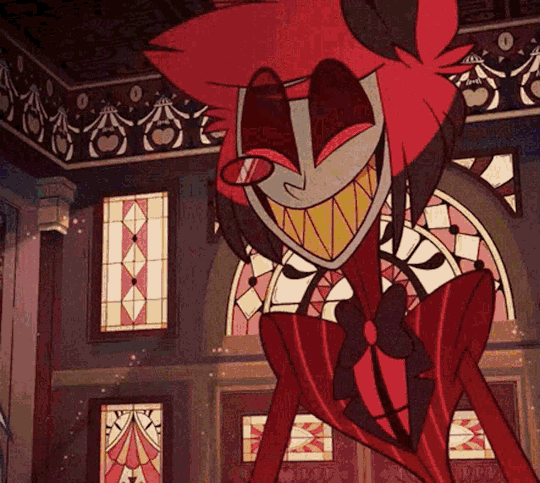
Alastor is very protective of you, since he had developed a very deep and abiding love for you. He is quick to defend you from others and will do whatever it takes to protect you.
He is a very powerful demon and when he is very angry or feels that someone has hurt you, he becomes very vicious and ruthless.
He has a fierce temper when he fels that anyone threatens to harm the ones he cared about, you most of all. The thought of someone even attempting to harm you incensed him and filled him with a burning rage. This trait is one of the things that you loved about him as you feel secure and safe with him.
When Alastor is upset or angry, his smile never fades from his cheeks but it shifts into a psychotic grin that frightens many,but not you. His eyes become hollow and cold, his breathing becomes rapid and his grin seems even wider than before. He gives off an air of menace and it is clear he is about to go on the attack. In this state, He often seems unhinged and out of control, but it is clear he still remains calculating and calm underneath. This state of his is frightening to many other demons, who tend to avoid him when he is like this.

When you're sick, he does his best to take care of you. He will cook you hot soup, brew you tea, bring you fresh water bottles and even rub your back and wipe your forehead to keep you comfortable. He is very attentive and caring when you are feeling ill and he will do everything he can to help you recover quickly and smoothly.
He will also do his best to entertain you while you are in bed, showing you all his favorite movies or programs [on his old tv],radio talking, joking around to make you laugh and even reading all the best books to you. [he will end up falling asleep cradling you on your bed,the radio will play 30' music,as Charlie gasps soflty saying how cute the two fo you looked as Vaggie tries to drags her gf away to do not disturb you.]

i hope you liked this and if you want more tell me and if you have doubts or questions if in the era of Alastor there were TVs, yes there were TVs at that time as the first TV was created in 1927 and he was killed in 1933.

i think Alastor would love old tvs unitl 1970 or 1980 because the others will remind him of Vox XD.
#hazbin hotel alastor#alastor x reader#fluffy#lovers#couple#romantic#couple goals#passion#affection#hazbin hotel#hazbin alastor#writer blog#writeblr#writers on tumblr#writers and poets#writerscommunity#foryou#cutemeltdown#artists on tumblr#cuddling & snuggling#warm and snuggly#headcanon#alastor headcanons#alastor fluff#hazbin hotel x reader
611 notes
·
View notes
Text
Welcome to the shitshow, fellow writers! Ready to suffer another November together?
Here's another November 1st meme to really set the tone
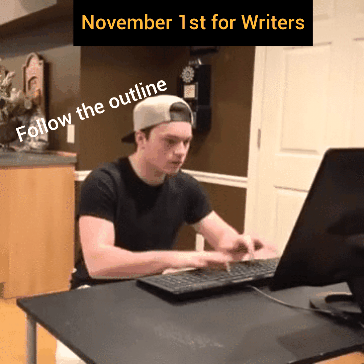
#writer blog#writerscommunity#writerblr#indie writer#writers of tumblr#national novel writing month#nanowrimo#nano 2023#writers#writer#writers block#writers on tumblr#writeblr#writing
791 notes
·
View notes
Text
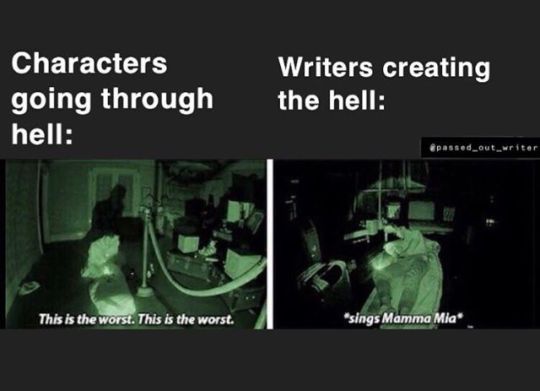
#writer#writing#writer memes#writer jokes#writer humor#being a writer#writer meme#writerblr#writer blog
489 notes
·
View notes
Text

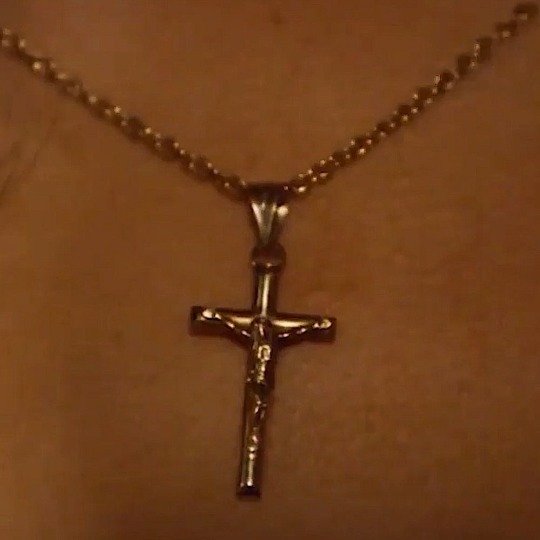




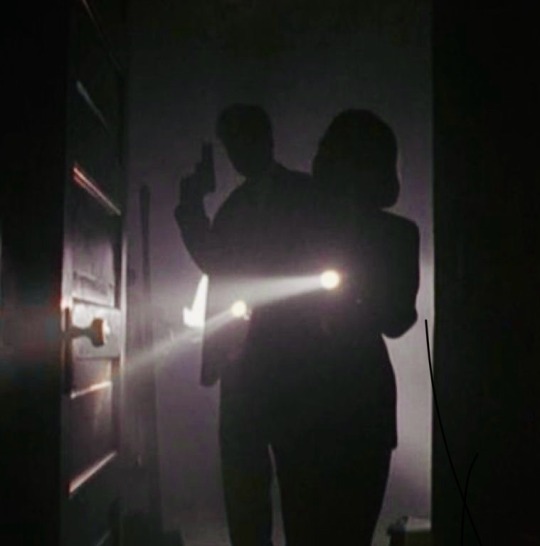



🕊️ just a lil jj!reader moodboard 🕊️
136 notes
·
View notes
Text
Prompt: 138
She was a tailor for vampires. Most of her job consisted of researching historical garments, learning to manufacture fabric and sew in styles not see in centuries, and trying to persuade her clients away from colours such as white or cream.
#writeblr community#writing#writeblr#creative writing#writing prompt#writing prompts#prompt#prompts#fantasy prompts#story prompts#writing inspiration#inspiration#writing vampires#vampire prompts#vampire writing#writer blog#requests open
248 notes
·
View notes
Text
Maturity is:
"Jab apko bahir ki 𝙧𝙤𝙣𝙖𝙦𝙚𝙞𝙣 mutaasir na kare, jab aap 𝙠𝙖𝙥𝙧𝙤𝙣 ke bajaye kapron main malboos shakhs ke zameer ko dekhe, jab apki 𝙩𝙖𝙬𝙖𝙟𝙟𝙤 shakal se zyada dil par ho, aap 𝙢𝙚𝙚𝙩𝙝𝙞 baaton se zyada kisi ke 𝙖𝙢𝙖𝙡 se khush ho, jab apko kisi se kuch 𝙬𝙖𝙦𝙩 guzaarne par 𝙖𝙛𝙨𝙤𝙤𝙨 na ho."
#urdu#urdu lines#urdu adab#urdu literature#urdu stuff#urdu poetry#fav#spilled truth#spilled words#spilled thoughts#spilled ink#writer on tumblr#writer on wattpad#writer on ao3#artist on tumblr#dark academia#light academia#choatic academia#aesthetics#desiblr#desi tumblr#pakistan#txt#maturity#deep thoughts#my writings#writings#writer blog#blog#indian cinema
61 notes
·
View notes
Note
Hi! I’m a fellow writer! Well, sorta a writer. I’ve always enjoyed writing since I like doing character studies, and outlining all sorts of plot. My notebooks and google docs are usually filled to the brim with WIP’s and writing prompts, however… none of these are really finished, because when I get to the actual part of writing itself; descriptions, dialogue, pacing, grammar. I usually get stumped here, and lose confidence to keep writing. I’d always find myself rewriting one paragraph, because usually, something is either lacking in description or there’s too much, the dialogues are unnatural and I’m usually left unsatisfied. So I drop it.
So I wanted to ask: How can I develop my writing skills, and or gain more confidence in my writing? I’m tired of letting good plots go to waste because I’m too scared of getting poor results.
This is such a great question, and the really simplistic answer is just to read lots and write lots.
The more you write, the more confident you'll become. And approaching the books you read like a writer, and taking the time to look at them analytically will start to show you what writing techniques and styles resonate with you, and which don't.
If you want a bit more detail, we have the article below available in the Reading Room! It's also got links to more details on close reading, developing a consistent writing practice, and how to find your unique writer's voice.
#writer blog#novlr#writing tips#writing asks#writers#creative writing#writing#writing community#writers of tumblr#creative writers#writing inspiration#writeblr#writerblr#writblr#writers corner#writers on tumblr#writers community#let's write#writing advice#writing resources#writers and poets#how to write#writer#writer's block#writer things#writers block#helping writers#help for writers#writing help#writing motivation
57 notes
·
View notes
Text
Been revising this novella lately and I’m actually quite surprised at how far my writing has come within the past six months. I started The Hinterlands to stay dedicated to writing during the year, to make sure I couldn’t make up any excuses as to why I couldn’t write, and it’s helped immensely with productivity and, evidently, improvement. It makes me wonder where I’ll be in five years or so, what will have changed. I’m curious as to what I’ll think of my writing now. Will I cringe? Will I admire it? Will I be completely indifferent? Will I be using any of the characters that I’m focusing on now, later on? How will their fates have changed? What kind of themes, what new stories will I have written?
Things like that are the kind of things I look forward to knowing. The future is promising!
#writing#literature#english literature#short story#writing community#short stories#fiction#thoughts#spilled thoughts#writers on tumbler#writeblr#writers on tumblr#creative writing#writing blog#writers and poets#writerscommunity#writer stuff#writer things#writerblr#writer blog#the hinterlands
90 notes
·
View notes
Text




A trip to the capital.
Good book, cold weather and excellent coffee, this trip was a very cozy one! We stayed at an old hotel from 1900s which at the time was used as a jazz cafe where musicians, authors and creators alike met to enjoy a nice atmosphere.
It was a nice trip, and now I am back again to focus on my upcoming exam in linguistics… it feels wierd; to have traveled for a weekend, experience new things and then to come back to the same old routines again. Back to school. Back to stuDYING.
#writers on tumblr#dark academia#writer blog#writerscommunity#dark academic aesthetic#blog post#bookblr#poetry#aestetic blog#reading#studyblr#cozyblr#study aesthetic#studyspo#study blog#cozymood#life blogging#lifestyle blog#studying#writerscorner#books and reading#coffee#travel
86 notes
·
View notes
Text
Writeblr Introduction

Please reblog!
Hello Writeblr! I'm oliveScales, and I'm currently writing and illustrating my webcomic named "The Forgotten Legends of Chima", or TFLOC for short.
I'm a fan of mythology and folklore, and I'm trying to study a few of them for my worldbuilding. Worldbuildings with focus on culture are my favorite! I also really like stories with animals and anthropomorphic characters. I'm an american who enjoys studying other cultures, and am currently studying the Portuguese language!
The Forgotten Legends of Chima is a fantasy science fiction story about the land of Chima, home to eight animal tribes. Here, you'll learn about their cultures, witness intriguing and complex relationships between them, and understand the importance of diversity.
TFLOC is an interpretation of Legends of Chima's storyline, which means that worldbuilding and characters are going to be developed alongside new content to add further depth into the story, such as unimportant/secondary characters becoming important and vital to the story.
Synopsis
In a world where civilizations clash for Chi in order to survive, Laval, prince of the Lion Tribe, strives to overcome every war and all injustice without ever gripping a sword. It all started when Laval witnessed evil and inequality with his own eyes. Since then, he has promised himself to protect anyone, no matter who they are, from suffering and that he will restore peace in the land of Chima. These are the Forgotten Legends of Chima.
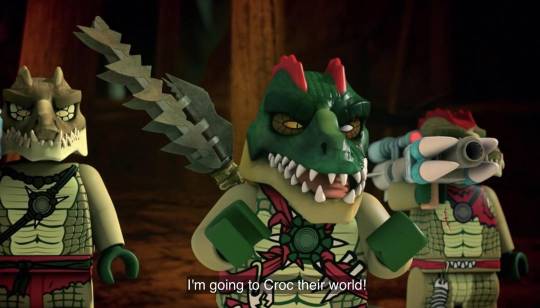
Chapter 1
Episode 1
Episode 2
Episode 3
Chapter 2
Coming soon :)
Sneak Peeks
TFLOC Full Sneak Peek
TFLOC Episode 2 Sneak Peek
TFLOC Sneak Peek (part 1)
TFLOC Sneak Peek (part 2)
TFLOC Sneak Peek (part 3)
TFLOC Sneak Peek (part 4)
TFLOC Sneak Peek (part 5)
TFLOC Sneak Peek (part 6)
TFLOC Sneak Peek (part 7)
TFLOC Sneak Peek (part 8)
TFLOC Sneak Peek (part 9)
TFLOC Sneak Peek (part 10)
TFLOC Sneak Peek (part 11)
TFLOC Sneak Peek (part 12)
TFLOC Sneak Peek (part 13)
TFLOC Sneak Peek (part 14)
TFLOC Sneak Peek (part 15)
TFLOC Sneak Peek (part 16)
TFLOC Sneak Peek (part 17)
TFLOC Sneak Peek (part 18)
TFLOC Sneak Peek (part 19)
TFLOC Sneak Peek (part 20)
TFLOC Sneak Peek (part 21)
TFLOC Sneak Peek (part 22)
TFLOC Sneak Peek (part 23)
TFLOC Sneak Peek 2 (part 1)
TFLOC Sneak Peek 2 (part 2)
(Check the #tfloc tag to see everything TFLOC related!)
Snippets
TFLOC Snippet 1
TFLOC Snippet 2
TFLOC Snippet 3
TFLOC Snippet 4
TFLOC Snippet 5
TFLOC Snippet 6
TFLOC Snippet 7
TFLOC Snippet 8
TFLOC Snippet 9
Laval and Lagravis
Worriz and Gorzan
Sir Fangar
Found Family (Tormak and Li'ella)
Heads Up Seven Up 1
Asks
Are there any proverbs [in Chima]?
When and why did you start writing?
Laval's purpose
Laval and Cragger
Storytelling Saturday
Character Ask (Laval)
WBW Chi Market
STS Halloween Party
Cragger character ask
Muse Monday Ask (Laval)
WBW ghost stories
Links
The Forgotten Legends of Chima Carrd
oliveScales' Carrd
oliveScales' Cohost
oliveScales' Toyhouse
oliveScales' Bluesky
#tfloc#signal boost#the forgotten legends of chima#writing#writeblr#writers#writers of tumblr#writerblr#writers on tumblr#writerslife#writblr#writerscommunity#writer blog#writerblr intro#writeblr intro#writeblr support#writeblr introduction#writeblr community#writeblogging#writebrl#writerscorner#legends of chima#lego legends of chima#lego chima
174 notes
·
View notes
Text
Everything You Need To Know About Writing Gunshot Wounds
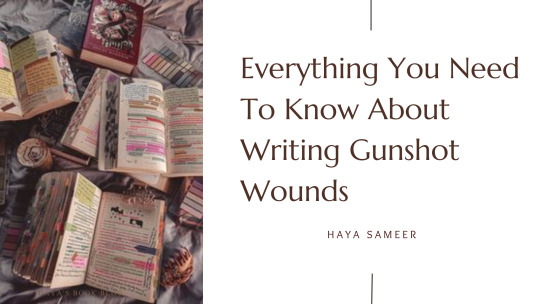
Welcome to the latest installment in my ongoing series on crafting realistic wounds in fiction! After covering stab wounds and burns, it's time to explore the next wound category frequently explored in fiction—gunshot wounds.
Gunshot wounds are a recurring motif in the realm of storytelling. They're something you can easily come across in every genre, however, authors often poorly portray gunshot wounds due to lack of proper research. I understand finding the right resources to aid with your writing can be hard, so here's my comprehensive guide on how to write gunshot wounds.
How To Categorise Gunshot Wounds
There are certain factors you need to consider before writing a gunshot wound. These details are instrumental in crafting a vivid and plausible narrative while avoiding plot holes. The first and most important one is identifying the type of firearm used to inflict the wound.
Picking The Right Firearm
Selecting the appropriate firearm to inflict a gunshot wound is a pivotal decision. It's not just about choosing any gun; it's about picking the right one to align with your desired outcome and the narrative's overall impact. Here's a quick guide on how to pick the right firearm.
The Impact of Firearm Selection
The firearm you choose can significantly influence the severity and appearance of the gunshot wound. Whether your goal is a graphic, gory injury or a precise, long-range shot, the choice of firearm plays a crucial role. Here are some guns you to consider:
Handguns: These are versatile and commonly used in close-quarters combat. They can result in gruesome, close-contact wounds with a higher potential for damage due to their stopping power.
Shotguns: Shotguns disperse shot pellets upon firing, making them suitable for creating a broader pattern of injuries. If you aim to depict a devastating, close-range gunshot wound, shotguns can be a fitting choice.
Rifles: Rifles are known for their accuracy at longer distances. When you need a precise, long-range shot, rifles are the go-to option. They tend to produce a cleaner wound channel, especially when used for a targeted, well-planned injury.
Choosing the Right Firearm for Your Narrative
The type of firearm you select should align with your story's objectives. If you intend to evoke visceral, gory reactions, opt for handguns or shotguns used in close proximity. On the other hand, if precision and long-range engagement are key, rifles can achieve your desired outcome.
Keep in mind that firearm selection can affect the wound's damage, trajectory, and overall portrayal in your narrative.
Categorising The Wound
Once you've identified the type of firearm, you need to establish what type of wound your character will incur.
In order to bring your character's injuries to life, it's important to first identify what you're dealing with. You can do this by categorising the injury based on several factors. For gunshot wounds, this includes the type of firearm used, the bullet's trajectory, and the specific areas of the body affected.
You can categorise your character's gunshot would into seven main categories, here's a quick breakdown of what these categories look like and the level of severity associated with them:
Penetrating Gunshot Wounds: These wounds occur when a bullet enters the body but doesn't exit. The bullet remains inside the body, causing damage along its path.
Perforating Gunshot Wounds: In this case, the bullet enters the body and exits on the opposite side. This type of wound can have a different set of implications due to the bullet's trajectory.
Ricochet Gunshot Wounds: Ricochet wounds happen when the bullet bounces off a surface before hitting the character. The nature of the surface can influence the severity of the wound.
Through-and-Through Gunshot Wounds: As the name suggests, these wounds occur when the bullet enters one side of the body and exits through the other. The trajectory can greatly affect the injury's severity.
Close-Contact Gunshot Wounds: These wounds result from the firearm being fired at extremely close range. The proximity of the gun to the body can lead to unique wound patterns and burn injuries.
Shotgun Wounds: Shotgun wounds differ from those caused by handguns or rifles. The shot pellets disperse upon firing, leading to a broader pattern of injury.
Long-Range Gunshot Wounds: When a character is shot from a considerable distance, the wound might appear different due to factors like bullet tumbling and loss of velocity.
The Anatomy of a Gunshot Wound
To create a vivid portrayal of a gunshot wound, writers need to grasp not only the external appearance but also the internal effects it has on the body. A well-executed description captures both the physical trauma and the emotional turmoil experienced by the character. Here are some symptoms you should take into consideration.
1. External Appearance and Bleeding:
Wound Size: The size of a gunshot wound can vary significantly based on the type of firearm and bullet used. Smaller calibers may leave entry and exit wounds that are relatively small, while larger bullets or high-velocity rounds can create much larger wounds. Be specific about the size, which can help readers visualize the injury.
Blood Loss: Gunshot wounds typically result in bleeding. The severity of bleeding depends on factors like the wound's location, the size of the blood vessels damaged, and the bullet's trajectory. Mention the amount of blood, but avoid excessive gore unless it serves a specific purpose in your narrative.
Coughing Up Blood: If the gunshot wound affects the chest or lung area, characters may cough up blood. This symptom often signifies a more critical injury and can add drama to your story.
2. Internal Damage and Symptoms:
Pain: Gunshot wounds are painful, and the character should express this pain through their actions, dialogue, and internal thoughts. Describe the sharp, burning, or throbbing sensations as they resonate through the character's body.
Shock: Depending on the severity of the wound, shock can set in. The character may appear pale, sweaty, and disoriented. This state of shock can impact their actions and decisions.
Loss of Function: A gunshot wound may impair the use of the injured body part. Describe any loss of function, such as the inability to move a limb or use it effectively.
Fainting: In extreme cases, characters may faint due to the pain, blood loss, or shock. Be sure to contextualize this within the narrative, as fainting can have significant consequences for the character.
By diving into the details of a gunshot wound's anatomy, you can craft a compelling and realistic portrayal that draws readers into the character's harrowing experience. I haven't exactly covered every symptom out there, but these are the major ones you should take into account when writing.
Medical Assessment and Treatment
Once you've established your gunshot wound, it's now time to focus on the aftermath. One of the main factors to consider is the medical process that follows. If your character is supposed to die from the gunshot then you could probably skip this section, but if they're alive here are things you need to consider.
1. Initial Assessment:
Scene Safety: In a real-life scenario, safety is paramount. First responders will ensure the scene is secure before approaching the injured person. Consider factors like the presence of firearms, potential threats, and the safety of medical personnel.
ABCs of Assessment: Medical professionals follow the ABCs—Airway, Breathing, and Circulation. Writers can reflect this in their storytelling by highlighting the character's ability to breathe, cough, or speak after being shot.
Vital Signs: Mentioning vital signs like heart rate, blood pressure, and oxygen saturation can help convey the character's condition and the urgency of their medical treatment.
2. Trauma Assessment:
Focused Assessment: Medical personnel perform a thorough examination to identify the gunshot wound's location, entry and exit points, and any associated injuries. This assessment informs their treatment plan.
Imaging: Depending on the complexity of the injury, X-rays or other imaging may be required to visualize the bullet's trajectory and any potential damage to internal organs or bones.
3. Treatment:
Bleeding Control: Stopping the bleeding is a top priority. This may involve applying pressure, packing the wound, or even tourniquet application in extreme cases.
Wound Care: Depending on the wound's severity, cleaning and suturing may be required. The character's response to this procedure can add an element of realism to your narrative.
Pain Management: Gunshot wounds are excruciatingly painful, and medical personnel will often administer pain relief or anesthesia during treatment.
Monitoring and Observation: Patients with gunshot wounds require careful observation and monitoring for signs of infection, complications, or changes in their condition.
By accurately portraying the medical assessment and treatment of gunshot wounds, you not only enhance the authenticity of your writing but also depict the physical and emotional toll such injuries can take on your characters. This attention to detail helps your readers connect more deeply with the story.
The Psychological Impact
Gunshot wounds don't just inflict physical harm; they also leave lasting emotional and psychological scars. It is important to note that the extent of the psychological impact on your characters will heavily rely on various factors.
For example, you need to consider whether or not this injury is something normal for them. Do they work as a spy, assassin, or other such roles that would mandate such dangerous injuries? You also need to consider who shot them. Does this wound come with emotional damage as well? Think of Aaron Warner’s reaction to Juliet shooting him.
If you’re sure your character will have some extent of a psychological impact, here are some factors you should consider.
1. Shock and Denial:
Immediate Response: Characters who have been shot may initially experience shock and denial. This can manifest as disbelief, emotional numbness, or a surreal sense of detachment from the situation.
Physical Symptoms: Shock can lead to physical symptoms like trembling, chills, or even fainting. Incorporating these details can make the character's reaction more genuine.
2. Fear and Anxiety:
Survivor's Guilt: Characters may grapple with survivor's guilt if they are the only ones to emerge unscathed in a violent encounter.
Anxiety: The threat of recurrence or the fear of returning to the location where the shooting occurred can trigger anxiety and panic attacks.
3. Post-Traumatic Stress Disorder (PTSD):
Flashbacks and Nightmares: Characters who have survived a gunshot wound may experience recurring flashbacks and nightmares, vividly reliving the traumatic event.
Hypervigilance: PTSD can lead to hypervigilance, where characters are constantly on edge, expecting danger at every turn.
4. Depression and Isolation:
Emotional Withdrawal: Characters may withdraw from social interactions, experiencing feelings of isolation and sadness.
Emotional Numbness: Some may describe feeling emotionally numb, unable to experience joy or pleasure.
5. Recovery and Resilience:
Therapeutic Support: In your storytelling, consider how characters seek therapy or counseling to cope with their emotional scars. Therapy can be a path toward recovery and resilience.
By addressing the psychological impact of gunshot wounds on your characters, you create more layered and relatable individuals within your narrative. This depth allows readers to connect with the characters on a profound emotional level.
I hope this blog on Everything You Need To Know About Writing Gunshot Wounds will help you in your writing journey. Be sure to comment any tips of your own to help your fellow authors prosper, and follow my blog for new blog updates every Monday and Thursday.
Looking For More Writing Tips And Tricks?
Are you an author looking for writing tips and tricks to better your manuscript? Or do you want to learn about how to get a literary agent, get published and properly market your book? Consider checking out the rest of Haya’s book blog where I post writing and publishing tips for authors every Monday and Thursday! And don’t forget to head over to my TikTok and Instagram profiles @hayatheauthor to learn more about my WIP and writing journey!
#hayatheauthor#haya's book blog#haya sameer#haya blogs#writers on tumblr#writer community#writer tools#writer blog#writer stuff#writer wednesday#writer tips#creative writing#writers of tumblr#writerscommunity#writeblr#writing community#writer spotlight#writer things#writing prompt#writing tools#writing stuff#writing#writing life#writing inspo#writing help#writing advice#writing inspiration#writing ideas#writing things#writing tip
2K notes
·
View notes
Text
||the lil bunny and the wolf||
Plot:Toji tease you in bed,after you two married ⸜(。˃ ᵕ ˂ )⸝♡
Toji here is cold but not with you,loves to tease you,a lot,possessive,romantic,reader is shy,inexpiernced,mute,problem at communicating,reader is autistic
Mention of abusive family (reader)
⋆𐙚₊˚⊹♡⋆𐙚₊˚⊹♡⋆𐙚₊˚⊹♡⋆𐙚₊˚⊹♡⋆𐙚₊˚⊹♡⋆𐙚₊˚⊹♡



“You’re a terrible liar.” Toji chuckles, smiling down at you “That blush tells all.” He leans down, hands still in your hips, and your bodies are almost touching. The closeness makes him happy, but he wants more. “What is it?” He whispers, his nose just barely grazing your neck.
“What bothers you so much?”
You dind't reply as you went immediatly to take his hand and placing your chin on his palm snuggling it,enjoying his soft skin.
Toji is shocked at the sudden movement, not expecting your reaction. But he isn’t entirely mad about it. He smiles as you snuggle into his palm and you rests your chin against it, letting your body touch his.
He moves his thumb against your chin, slowly turning it upwards to make you look at him again. He leans down towards you,until your noses are close again. He gazes at you with a small smirk.
“Better?” He whispers, his thumb sliding down your face and stopping at your chin.
Toji chuckles, his smile growing wider as you snuggles against his nose. You're such a small and adorable thing, enjoying being held by his massive hands and arms. He could crush you if he wanted to.
Instead, he rubs your back gently with one of his hands, his thumb running up and down the back of your neck with the occasional stroke of your hair.
“You’re like a little bunny” he whispers, the smile still plastered on his face.
"wolf" you said in a kid tone pointing at Toji,you never talked before but you enjoyed Toji company "i like..Toji.." your words were slurred and almost silent but you couldn't stop humming
Toji’s face lights up as you whispers his name, and when you call him a wolf, he makes a playful growl.
He grins down at you, amused by your small voice. You're been mute all your life, even when you were betrothed. Now you decided to talk?
“You never spoke before, why now?” He asks, still rubbing your back gently, his hands starting to go further down your back.
Toji chuckles at your little smile. It’s adorable. For all the years that you're been mute, you finally speaks, with such a soft and silky voice.
“I love your voice” he says softly, leaning down to rest his nose against yours. “If anyone makes fun of you, I’ll deal with them personally.”
“I want to hear you laugh. Whisper. Scream. Sing. I want to hear everything you have to say”
A loud giggle erupted from your lips but you immediatly coverd your mouth "sorry…" you said looking down,pouting
Toji snorts loudly, amused by the sudden outburst. It’s adorable, and he can’t help but smile at you as you covers your mouth.
“Don’t apologize” He whispers, moving your hands away from your mouth. “I want to hear you laugh some more.”
He brings his face closer, your noses touching again as they grin at each other. “I want to hear that little giggle again.”
You giggle again at his request, letting yourself enjoy the moment with this huge man. You're always had to be silent, forced to stay mute or else your parents would punish you.
But with Toji, you feels like you can do anything. No one’s there to stop you. You're free.
“I want to hear your little giggles every day,” he continues, wrapping one arm around your waist and pulling you bit closer to him. “I want to see you smile every day. I want to see you happy. No one is allowed to make fun of you again. Only I’m allowed to make fun of you.”
His voice is low and serious, though that smirk of his doesn’t disappear. He’s dead serious, and not joking at all.
“Do you understand?” he whispers to you, as he brushes your hair away from your neck. He rests his hands on your waist as you stare at each other.
“Only I’m allowed to make fun of you, only I get to hear you laugh. From now on, no one else gets to hurt you. I don’t want anyone making fun of my wife.”
Toji pauses for a moment, studying you. You're so tiny and vulnerable, and so easily hurt by the words of strangers. It makes him hate the world a little bit.
“Promise me you won’t listen to them anymore, okay?” The former assassin whispers, his arms tightening around you as he runs his hand down your back. “When they make fun of you, you’re going to turn to me and laugh. No matter the insult, I want to hear you laugh. Then I can tell them to shut up.”
“Mhm.” Toji leans down, pressing his forehead against yours. You continue to stare at each other, and he lets out a quiet chuckle. “My beloved wife.” He smiles, his thumb stroking your chin before running it down your neck and onto your shoulders.
“And my beloved wife never cries.”
“Never.” Toji’s voice is a low whisper as he wraps his free arm around your shoulder. They’re pressed so close together, their bodies touching, but it feels nice. Warm. Toji stares at you, humming a bit, and smiles at the thought of his wife.
For a moment, he just looks at you, enjoying the feeling of your presence.
“Let’s make each other happier” he murmurs, tilting his head for a kiss.
Toji pulls you into a deep, passionate kiss, grabbing your waist and pulling you even closer to him as his lips press against yours. He presses against your bodies, making sure his arms are wrapped around you tightly.
His tongue explores your mouth, and he enjoys the feel of your body against him. He breaks away from the kiss abruptly, panting heavily as he breaks free.
“Much happier” he whispers to you, panting heavily, grinning at the sweet, small woman in front of him.
#toji x you#jjk toji#jjk#jujutsu kaisen manga#jujutsu kaisen x reader#jjk fanfiction#writer blog#writers on tumblr#toji x reader#toji fushiguro#couple goals#mute#omg this is so fricking cute#cutemeltdown#i love him
120 notes
·
View notes
Text
Instead of writing a character outline for your story full of bulletpoints, what if you just flat out interviewed them?
I'd happily read five pages of my favorite authors sitting in a living room asking their characters about their feelings on Avocados for five minutes.
You think this is a joke but honestly you start down that road and suddenly you're talking about their feelings on equality and human rights and their thought process after the love of their life moved to Buttswan™, USA.
Or maybe that's just my undiagnosed ADD...
#writer blog#writerblr#writers of tumblr#writerscommunity#indie writer#writeblr#writersociety#writer memes
971 notes
·
View notes
